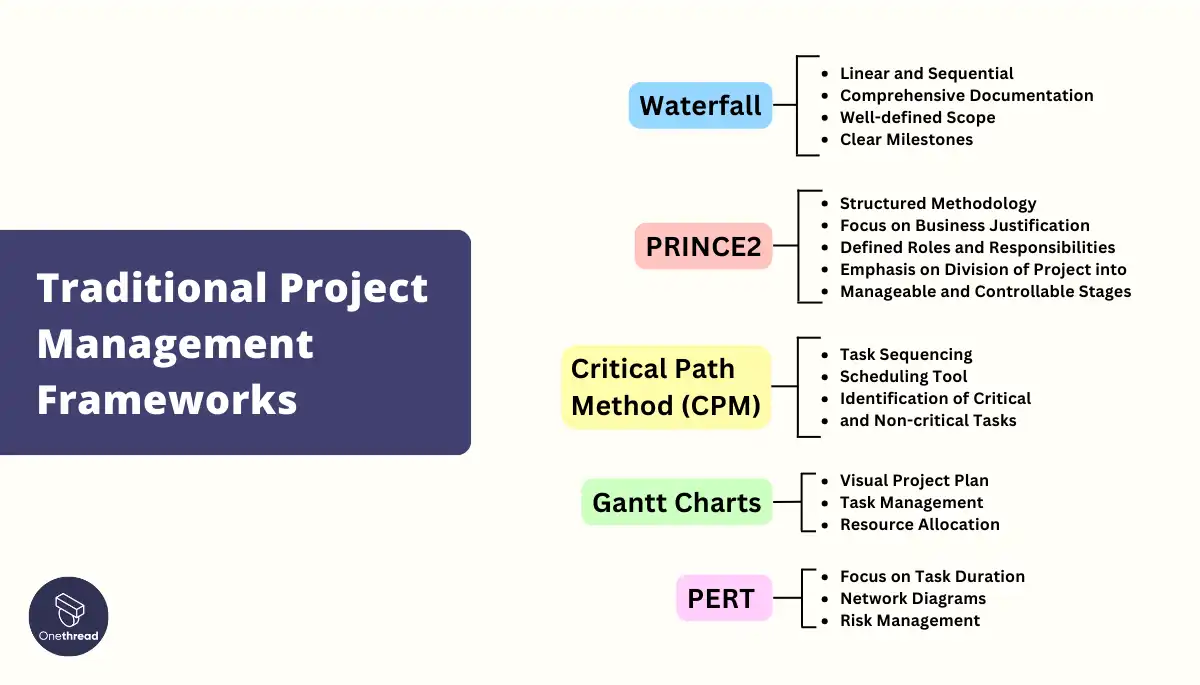Traditional follows a linear, sequential approach with rigid planning, while Agile is iterative and flexible, allowing changes. Similarity – Both aim to deliver projects successfully, involving planning, execution, and stakeholder communication. Traditional suits projects with well-defined requirements, while Agile excels in dynamic environments with evolving needs.
Explore the variation of these methodologies, their pros and cons, and guidance on choosing the right approach for your project needs in our comprehensive analysis.
Key Takeaways:
- Traditional Project Management offers a linear, step-by-step approach ideal for projects with clear, unchanging requirements.
- Agile Project Management emphasizes flexibility, allowing for iterative changes and adjustments based on ongoing feedback.
- Choosing between Agile and Traditional depends on project complexity, team dynamics, stakeholder involvement, and adaptability needs.
- Both methodologies aim to deliver successful projects, but Agile is better suited for dynamic environments requiring quick adaptations.
What Is Traditional Project Management?
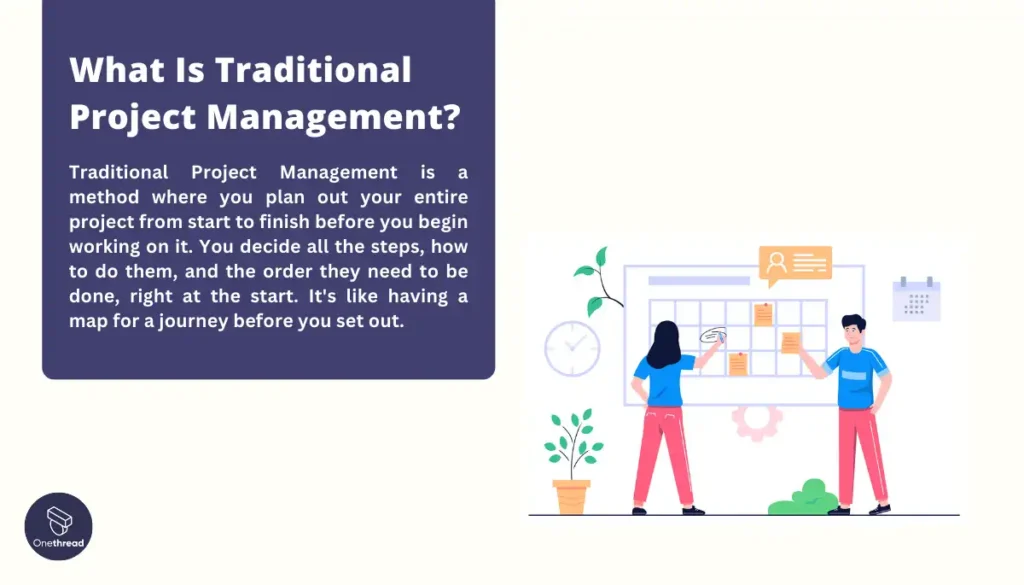
Traditional Project Management is a method where you plan out your entire project from start to finish before you begin working on it. You decide all the steps, how to do them, and the order they need to be done, right at the start. It’s like having a map for a journey before you set out.
This way is really organized because it lets you see the whole project at once. It works best for projects where you know exactly what needs to happen and when. It’s a straightforward, step-by-step approach to finishing a project.
Traditional Project Management Frameworks
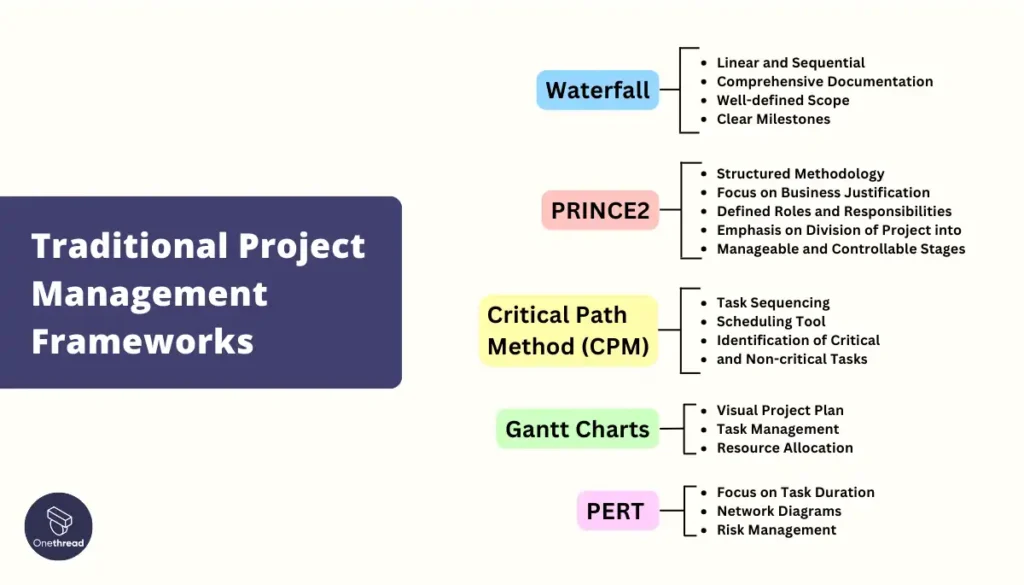
Traditional project management frameworks offer a structured and predictable approach to managing projects. These frameworks are characterized by their linear processes, clear documentation, and defined phases, making them ideal for projects with fixed scopes and requirements that demand meticulous planning and control.
Waterfall
- Linear and Sequential: Follows a fixed sequence of phases: requirements, design, implementation, verification, and maintenance.
- Comprehensive Documentation: Each phase has its set of documents that are completed before moving to the next phase.
- Well-defined Scope: The project scope and requirements are determined at the beginning and remain unchanged.
- Clear Milestones: Specific milestones mark the completion of each phase, facilitating project tracking and management.
PRINCE2 (Projects IN Controlled Environments)
- Structured Methodology: Provides a detailed process-based approach for project management, divided into manageable stages.
- Focus on Business Justification: Requires a clear business case with defined organizational benefits, costs, risks, and timelines.
- Defined Roles and Responsibilities: Specifies roles and responsibilities for the team, ensuring clarity in project execution and governance.
- Emphasis on Division of Project into Manageable and Controllable Stages: Facilitates better control by breaking down the project into stages that are easier to manage and control.
Critical Path Method (CPM)
- Task Sequencing: Identifies the longest stretch of dependent activities and measures the time required to complete them.
- Scheduling Tool: Helps project managers to estimate the project duration and allocate resources efficiently.
- Identification of Critical and Non-critical Tasks: Enables teams to prioritize tasks that are critical for project completion on time.
Gantt Charts
- Visual Project Plan: Offers a visual timeline for the project, showing tasks, durations, and dependencies.
- Task Management: Allows for easy tracking of task progress, start and end dates, and overlapping activities.
- Resource Allocation: Facilitates the management of resources and ensures that work is evenly distributed among team members.
PERT (Program Evaluation and Review Technique)
- Focus on Task Duration: Uses probabilistic time estimates for tasks rather than fixed durations, offering a range of possible completion times.
- Network Diagrams: Visualizes the project tasks and their dependencies, allowing for the identification of the critical path.
- Risk Management: Helps in identifying potential delays and preparing contingency plans.
Traditional Project Management Frameworks provide a solid foundation for managing projects that benefit from a high degree of planning, predictability, and control.
Traditional Project Management Approach
One real-life example of Traditional Project Management is the construction of a bridge. In such a project, every step must be meticulously planned before any work begins. The process follows a linear path:
- Initiation: The need for a new bridge is identified, perhaps to connect two parts of a city separated by a river.
- Planning: Engineers design the bridge, calculating materials, costs, and timelines. This phase includes detailed plans for every aspect of the construction process.
- Execution: Construction begins. This follows the plan closely, with each part of the bridge built in a specific sequence — foundations first, followed by supports, and finally the road or pathway itself.
- Monitoring and Controlling: Throughout the construction, project managers oversee the work to ensure it matches the initial plan. Adjustments are difficult and costly because each step builds on the previous one.
- Closure: Once the bridge is completed, it’s inspected to ensure it meets all safety and quality standards. The project concludes with a final report and a formal handover to the client or city.
In this example, the traditional methodology example approach is suitable because the project has clear, defined stages, and changes mid-construction could have significant implications for safety and costs.
What Is Agile Project Management?
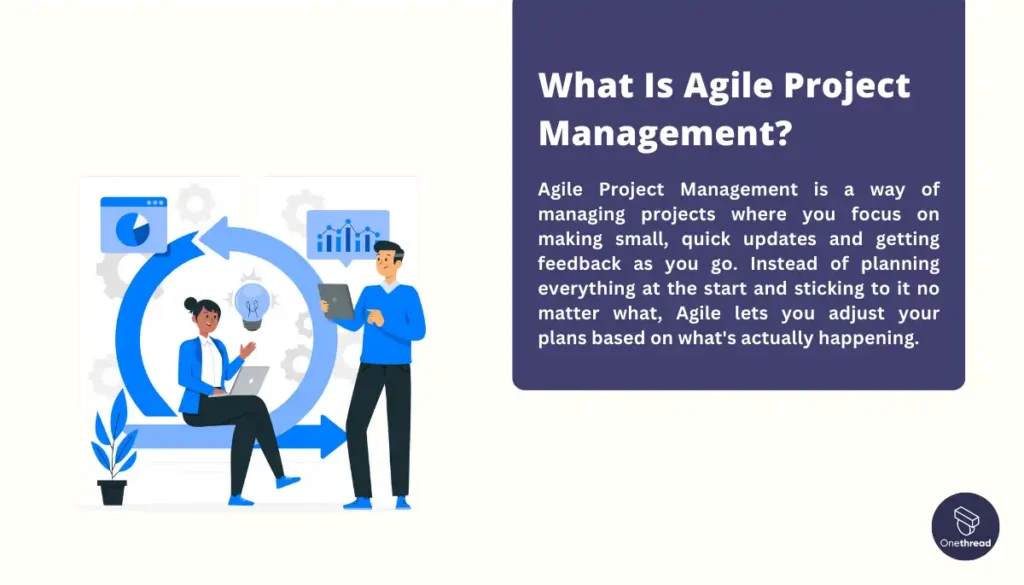
Agile Project Management is a way of managing projects where you focus on making small, quick updates and getting feedback as you go. Instead of planning everything at the start and sticking to it no matter what, Agile lets you adjust your plans based on what’s actually happening.
This means you can fix problems or make improvements right away. It’s like playing a video game where you move through levels quickly, learn from your mistakes, and try again, getting better each time.
Agile involves everyone in the project more closely, including the people you’re creating the project for, so you can make sure you’re always on the right track and making something they’ll really like.
Core principles of Agile methodology
Agile methodology focuses on teamwork, customer feedback, and flexible planning to make sure the project meets its goals effectively. Let’s go into its core principles:
Individuals and Interactions Over Processes and Tools
This principle values people and teamwork more than sticking strictly to processes or using specific tools. It’s about making sure the team can work well together and solve problems adaptability and creatively, rather than just following a set of instructions without thinking.
Working Software Over Comprehensive Documentation
Agile prioritizes creating a working project or product that people can use and test over spending lots of time writing detailed documents about it. It means focusing on making something useful quickly, rather than ensuring every detail is perfectly documented before moving forward.
Customer Collaboration Over Contract Negotiation
Instead of spending ages negotiating all the details of a project upfront, Agile encourages ongoing conversations with customers. This way, you can make adjustments based on their feedback as you go, leading to a result that better meets their needs.
Responding to Change Over Following a Plan
Agile is all about being open to change and ready to adapt when needed. Even if you have a plan at the start, you’re prepared to change it based on new information or feedback. This helps keep the project relevant and effective, even when unexpected things happen.
Agile Practices And Frameworks
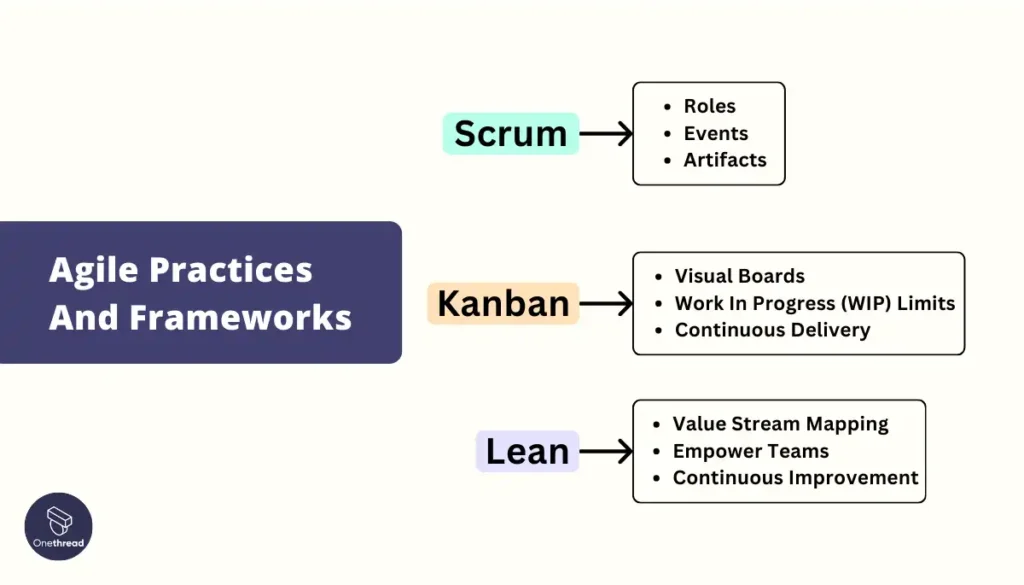
Agile Practices are methodologies that embody the Agile Manifesto’s core values and principles, focusing on customer collaboration, adaptability, and iterative progress. They prioritize:
- Active and continuous collaboration among team members and stakeholders.
- The frequent delivery of functional product increments.
- Flexibility in responding to evolving project requirements.
- Rapid adaptation to feedback to ensure the product meets customer needs.
Agile Frameworks offer structured methods to apply these practices, each with unique processes and tools designed to facilitate Agile project management.
Scrum
Scrum is a framework that employs short development cycles called Sprints, typically lasting 2-4 weeks, to focus on delivering specific features or product increments.
- Key Features:
- Roles: Defines specific roles like Scrum Master, Product Owner, and Development Team, each with distinct responsibilities.
- Events: Utilizes ceremonies such as Sprint Planning, Daily Stand-Ups, Sprint Reviews, and Sprint Retrospectives to ensure continuous progress and adaptation.
- Artifacts: Employ Scrum Artifacts like the Product Backlog, Sprint Backlog, and Product Increment to manage and track the work.
It uses roles like the Scrum Master and Product Owner, and events such as daily stand-ups and sprint reviews, to keep the team moving quickly and efficiently towards their goal. It’s great for projects that need to adapt and change direction easily, and concepts covered in a CSPO certification often align with this approach.
Kanban
Kanban is a visual framework used to implement Agile that focuses on visualizing the entire project on boards to enhance workflow and productivity.
- Key Features:
- Visual Boards: Uses Kanban boards to visualize work in progress and flow through different stages.
- Work In Progress (WIP) Limits: Implements limits on the number of tasks in each stage to prevent bottlenecks and promote continuous flow.
- Continuous Delivery: Emphasizes the steady, continuous delivery of value without the fixed iteration lengths found in Scrum.
It helps teams visualize their work, limit the amount of work in progress, and deliver continuous improvements without overloading team members. It’s perfect for teams that want a flexible way to manage workflow and prioritize tasks.
Lean
Lean methodology is a principle-based approach that emphasizes maximizing value while minimizing waste. It focuses on creating more value for customers with fewer resources.
- Key Features:
- Value Stream Mapping: Identifies and streamlines the process steps that directly contribute to value creation, eliminating those that do not.
- Empower Teams: Encourages the decentralization of decision-making to the team members who are closest to the work.
- Continuous Improvement: Focuses on constant improvement of the process through feedback and learning.
Lean principles help teams identify and cut out unnecessary steps in their process, making sure every task adds value to the project and helps get it to the customer faster. It’s ideal for teams looking to optimize their workflow and increase efficiency.
Agile Project Management Approach
The Agile Project Management Approach emphasizes adaptability, collaboration, and customer feedback. It focuses on delivering value through iterative development, allowing for rapid responses to change and ensuring products meet user needs. This flexible approach fosters innovation and aligns closely with dynamic project environments.
- Iterative Development: Breaks the project into small, manageable increments or sprints, allowing for frequent reassessment and adjustments.
- Customer Collaboration: Engages customers throughout the development process, incorporating their feedback to refine and improve the product continuously.
- Adaptive Planning: Encourages flexible planning that evolves with the project, enabling teams to quickly pivot in response to changes or new insights.
- Cross-Functional Teams: Utilizes teams composed of various functional experts, promoting collaboration and innovation to solve problems more efficiently.
- Continuous Delivery: Aims for the frequent release of product increments, providing immediate value to customers and stakeholders.
- Responding to Change: Prioritizes the ability to adapt over following a fixed plan, recognizing that change is both inevitable and an opportunity for improvement.
- Emphasis on People and Interactions: Values effective communication and team collaboration over rigid processes and tools.
- Sustainable Work Pace: Promotes a balanced approach to workload, ensuring team members remain productive and motivated without burnout.
- Regular Reflection and Adjustment: Incorporates regular retrospectives for the team to reflect on their performance and identify areas for improvement.
Agile’s flexible and iterative nature makes it particularly suited for projects in rapidly changing environments, where stakeholder input and adapting to evolving requirements are crucial for success.
Key Differences Between Traditional And Agile Project Management
Traditional project management follows a sequential, plan-driven approach with rigid processes, whereas agile embraces an iterative, flexible methodology.
In traditional methods, there is extensive upfront planning, however, agile adapts to changes through continuous feedback and improvement cycles.
Furthermore, traditional projects have clear roles, responsibilities, and long approval processes, unlike Agile’s self-organizing, cross-functional teams that facilitate frequent deliveries.
Consequently, traditional suits projects with stable requirements, while on the other hand, agile excels in dynamic environments with evolving needs.
Ultimately, traditional methods excel in predictability, while in contrast, agile thrives on responsiveness to change.
Here’s a concise table summarizing the key differences between Traditional and Agile Project Management:
Aspect | Traditional Project Management | Agile Project Management |
Core Principles | Sequential execution of project phases, Detailed upfront planning, Minimal changes to the plan | Iterative and incremental development, Embrace change, Continuous customer collaboration |
Approach to Project Planning | Linear and sequential | Iterative and incremental |
Flexibility & Adaptability | Low; changes are difficult to implement after planning. | High; adapts to changes easily throughout the project. |
Project Requirements | Prioritizes following a strict plan and meeting project requirements. | Prioritizes customer satisfaction and working software. |
Communication | Rely on written documentation. Formal communication. | Encourages face-to-face communication and collaboration. |
Organization | Hierarchically organized teams. | Self-organizing teams. |
Development Model | lifecycle model. | Evolutionary delivery model. |
User Requirement | Clearly defined before initiating or implementation. | Interactive inputs. |
Team Functionality | Functionally divided teams. | Cross-functional teams. |
Test Documentation | Comprehensive test planning. | Tests are planned one sprint at a time. |
Feedback Cycles | Feedback is typically received after project completion. | Regular feedback loops throughout the project. |
Project Phases and Planning | Uses longer project phases for planning and delivery. Has a rigid plan that is difficult to change. | Uses short sprints for planning and delivery. Allows for changes and adjustments throughout the project. |
Client Involvement | Low. | High. |
Project Scale | Large-scale. | Small and Medium scale. |
Delivery | Delivery upon project completion. | Continuous delivery throughout the project. |
Risk Management | Risks are identified and managed during the initial phases. | Risks are managed continuously through regular iterations. |
Model Preference | The traditional model favors anticipation. | The agile model favors adaption. |
Effort Estimation | The project manager provides estimates and gets approval from the PO for the entire project. | Scrum master facilitates and the team does the estimation. |
Reviews and Approvals | Excessive reviews and approvals by leaders during the project | Reviews are done after each iteration. |
Key Features | Linear Phases, Detailed Planning, Fixed Scope, Predictability, Formal Documentation, Emphasis on Planning and Design | Iterative and Incremental Development, Emphasis on Customer Collaboration, Adaptive Planning, Cross-functional Teams, Focus on Working Software, Sustainable Development Pace, Continuous Improvement |
Advantages | Predictability in schedule and budget, Clear documentation, and process, Suitable for stable projects with clear requirements, Flexibility to change requirements, Faster delivery and feedback, Higher customer satisfaction | Predictability in schedule and budget, Clear documentation and process, Suitable for stable projects with clear requirements, Flexibility to change requirements, Faster delivery and feedback, Higher customer satisfaction |
These insights can help organizations and project managers choose the most appropriate approach based on the project’s needs, complexity, and the level of uncertainty involved.
Core Principles
Traditional project management emphasizes sequential execution and detailed upfront planning, whereas Agile project management focuses on iterative development and embracing change.
Agile’s core principles champion adaptability and customer involvement at every stage. This approach not only accommodates but thrives on change, making it ideal for projects in dynamic environments where stakeholder feedback is crucial for success. Agile’s iterative nature allows for constant improvements, ensuring that the final product closely aligns with customer needs and expectations.
Traditional project management, with its sequential execution and detailed upfront planning, is incomparable in environments where stability and predictability are vital. It shines in scenarios where changes are minimal and requirements are clearly defined from the outset, providing a solid framework for complex projects that benefit from a structured approach.
Approach to Project Planning
Traditional project management adopts a linear and sequential approach, contrasted with Agile’s iterative and incremental model.
Agile planning is different from the traditional planning approach as agile planning is more flexible and iterative, adapting to changes and feedback throughout the project. It breaks the project into smaller, manageable parts (sprints), allowing for regular reassessment and adjustments.
Traditional planning, on the other hand, outlines the entire project upfront in a detailed plan that rarely changes. It follows a linear path, completing one phase before moving to the next.
Agile focuses on continuous improvement and customer satisfaction, while traditional planning emphasizes predictability and control over the project scope, schedule, and budget.
Flexibility and Adaptability
Traditional project management offers low flexibility in implementing changes after planning, while Agile adapts easily throughout the project lifecycle.
Changes in Traditional Project Management can be challenging and costly, as deviating from the initial plan requires formal procedures and can impact the project’s timeline and budget.
Agile thrives on adaptability, welcoming changes even late in the project. This approach is more like improvising your path based on real-time discoveries, ensuring the project remains relevant and meets user needs effectively.
Project Requirements
Traditional project management requires detailed requirement gathering and strict plan adherence, while agile project management excels in adapting to evolving project requirements and prioritizing customer satisfaction.
For those prioritizing adherence to predefined project requirements and a structured plan, traditional project management stands out. Its approach ensures projects follow a detailed blueprint from start to finish, providing stability and predictability.
Agile project management, however, is the go-to for adapting to evolving requirements and prioritizing customer feedback. It offers flexibility in project execution, making it ideal for projects where end-user satisfaction and the ability to pivot are critical.
Communication
Traditional project management relies on written documentation and formal communication, in contrast to Agile’s emphasis on face-to-face interaction and collaboration.
This emphasis on direct communication ensures that information is conveyed more efficiently and misunderstandings are minimized, leading to faster decision-making and problem resolution. Agile’s collaborative environment encourages team cohesion and stakeholder engagement.
Traditional project management, with its reliance on formal documentation, excels in contexts where records and audit trails are essential. It provides a clear, documented basis for communication that is invaluable in large-scale projects or industries with strict regulations.
Organization
Traditional project management relies on a hierarchical organizational structure to set clear lines of authority and responsibility, whereas agile project management encourages self-organizing teams that promote autonomy and flexibility.
In environments where clear hierarchies and defined lines of responsibility are essential, traditional project management offers an organized and systematic approach. This structure supports accountability and simplifies complex project coordination.
Agile project management, in contrast, suits dynamic environments that benefit from team autonomy and flexibility. Its emphasis on self-organizing teams encourages innovation and rapid problem-solving, leveraging diverse team strengths.
Development Model
Traditional project management utilizes a lifecycle model, ensuring a structured and phased approach to project development, in contrast to agile project management’s evolutionary delivery model, which emphasizes continuous improvement and adaptation.
Traditional project management, with its lifecycle model, is suited for projects that benefit from extensive planning and a phased execution approach. This model provides a clear framework for achieving project milestones systematically.
For projects in fast-paced and uncertain environments, agile project management’s evolutionary delivery model supports continuous adaptation and improvement, focusing on delivering working increments and ensuring project relevance.
User Requirements
Traditional project management focuses on defining user requirements upfront and minimizing changes, while agile project management encourages ongoing interaction with users to refine and adapt requirements as the project evolves.
Projects with well-defined user requirements upfront, unlikely to change, align with traditional project management. This approach ensures all stakeholder expectations are clearly understood and met with minimal deviation.
Agile project management, however, thrives on interactive inputs and flexibility, making it ideal for projects where user needs and market demands may evolve, ensuring continuous alignment and refinement based on feedback.
Team Functionality
Traditional project management divides teams based on functional expertise, ensuring depth in specific areas, whereas agile project management promotes cross-functional teams, leading to a holistic and collaborative approach to project tasks.
When projects require deep functional expertise within specific areas, traditional project management’s division of teams by function ensures in-depth knowledge and focused execution.
On the other hand, agile project management’s cross-functional teams are better suited for projects benefiting from collaboration and a holistic view. This setup enables innovation and quick adaptation to project challenges.
Test Documentation
Traditional project management emphasizes comprehensive test planning and documentation, in contrast to agile project management, where tests are planned incrementally and focus on immediate sprint objectives.
For projects where comprehensive test planning and documentation are necessary, traditional project management offers a thorough approach to quality assurance, aligning with industries that demand detailed records.
Agile project management, on the contrary, with its incremental test planning, suits projects that require flexibility and speed in testing, allowing for rapid iterations and adjustments based on immediate results.
Feedback Cycles
Traditional project management typically gathers feedback after significant milestones or project completion, while agile project management incorporates regular feedback loops throughout the project to continuously align with stakeholder expectations.
Traditional project management is optimal for projects that gather feedback at significant milestones or completion, suitable for environments where changes are less frequent and feedback cycles are longer.
In contrast, agile project management’s regular feedback loops throughout the project ensure continuous alignment with stakeholder expectations and project goals, ideal for projects that benefit from iterative refinement.
Project Phases and Planning
Traditional project management follows a sequential phase approach, providing clarity and predictability, against agile project management’s iterative planning and delivery, which allows for greater flexibility and responsiveness.
Projects that benefit from clear, sequential phases and comprehensive upfront planning align with traditional project management. This approach provides predictability and structured progression through the project lifecycle.
However, agile project management’s iterative planning and delivery are suited for projects requiring flexibility and the ability to respond to changes swiftly, emphasizing adaptability over strict adherence to a plan.
Client Involvement
Traditional project management often limits client involvement to key milestones and decision points, whereas agile project management encourages high client involvement throughout the project for continuous feedback and collaboration.
Traditional project management is well-suited for projects where client involvement is concentrated at the beginning and end, providing a clear, unchanging vision throughout the project.
On the other hand, agile project management emphasizes high client involvement throughout, ideal for projects where ongoing client feedback and collaboration are crucial for aligning the project with client expectations.
Project Scale
Traditional project management is well-suited for large-scale projects requiring detailed oversight and coordination, in contrast to agile project management, which can efficiently manage both small and medium-scale projects by leveraging its adaptability and iterative nature.
For large-scale projects requiring detailed oversight and coordination, traditional project management offers a structured approach that facilitates comprehensive planning and execution.
Agile project management, in comparison, with its adaptability and iterative nature, is effective for managing both small and medium-scale projects, where flexibility and responsiveness to change are advantageous.
Delivery
Traditional project management aims for a comprehensive delivery at the project’s conclusion, ensuring that all aspects are thoroughly completed, while agile project management focuses on continuous delivery throughout the project, providing incremental value.
Projects aiming for a comprehensive delivery at the conclusion align with traditional project management, ensuring all aspects are completed to specification before delivery.
In contrast, agile project management focuses on continuous delivery throughout the project, providing value incrementally and allowing for adjustments based on early feedback, suitable for projects benefiting from early and frequent evaluations.
Risk Management
Traditional project management employs proactive risk management, identifying and mitigating risks early in the process, whereas agile project management adopts a reactive stance, adjusting to risks and changes as they emerge through iterative cycles.
Traditional project management, with its proactive risk management, identifies and addresses risks early, making it suitable for projects where minimizing uncertainty is a priority.
On the contrary, agile project management’s reactive approach to risk management, adjusting to risks and changes through iterative cycles, suits projects where flexibility and the ability to pivot are crucial.
Model Preference
Traditional project management prefers a model that anticipates changes and plans for them upfront, contrasting with agile project management’s preference for a model that adapts and responds to changes as they occur.
For projects benefiting from anticipation and upfront planning to accommodate changes, traditional project management’s model offers predictability and control.
Agile project management’s model, however, favoring adaptation and responsiveness to change, is ideal for projects in dynamic environments where flexibility and rapid decision-making are valued.
Effort Estimation
Traditional project management relies on the project manager for effort estimation and approval from stakeholders, while agile project management involves the team in the estimation process, reflecting a collaborative approach to project planning.
When projects require centralized effort estimation and formal approval processes, traditional project management provides a structured approach to planning and resource allocation.
In contrast, agile project management involves the team in effort estimation, enabling a collaborative approach to project planning and execution, suitable for teams prioritizing agility and collective decision-making.
Reviews and Approvals
Traditional project management structures the project with stages requiring specific reviews and approvals before moving forward, whereas agile project management incorporates reviews and approvals as part of each iteration, contributing to continuous improvement and stakeholder engagement.
Projects that benefit from staged reviews and formal approvals align with traditional project management, offering clarity and milestones for progress assessment.
Agile project management, in comparison, incorporates reviews and approvals as part of each iteration, promoting continuous improvement and stakeholder engagement, ideal for projects that thrive on frequent reassessment and adaptation.
As we’ve discussed the basic differences between the two most used project management approaches, it’s time to dig deeper and know their key features in detail.
Key Features of The Traditional Methodology
Traditional project management methodology is characterized by its structured approach, emphasizing detailed planning, clear stages, and formal documentation. This linear process ensures predictability and stability, making it suitable for projects with well-defined objectives and little change expected throughout their lifecycle. Now, let’s break down its key features:
Sequential Phases
Traditional methodology follows a linear project life cycle, divided into distinct phases such as initiation, planning, execution, monitoring, and closure. You start at point A and manage a project step by step to point B. Each phase must be completed before moving on to the next, ensuring thoroughness and clarity at each step.
Detailed Planning
A cornerstone of traditional project management is the emphasis on detailed planning before project execution.
This involves setting clear objectives, defining scope, and preparing comprehensive schedules and budgets, minimizing risks and uncertainties throughout the project.
Formal Documentation
Traditional methodology prioritizes extensive documentation, including project plans, requirements specifications, and progress reports.
This formal documentation serves as a reference point for the project, ensuring alignment among stakeholders and compliance with regulatory standards.
Defined Roles and Responsibilities
A clear definition of team roles and responsibilities is fundamental in traditional project management. This clarity facilitates efficient coordination and communication, ensuring that each team member understands their tasks and how they contribute to the project’s objectives.
Risk Management
Risk management is a proactive part of traditional project management, with risks identified, assessed, and mitigated during the planning stages.
This approach helps minimize potential issues that could impact the project timeline or budget.
Change Control
In traditional project management, any changes to the project scope or objectives are managed through a formal change control process.
This ensures that any modifications are thoroughly evaluated and approved before implementation, maintaining the project’s integrity.
Quality Assurance
Quality assurance processes are embedded throughout the traditional project lifecycle, with predefined standards and benchmarks guiding the quality of work. Regular reviews and audits ensure that the project outputs meet the required standards and specifications.
Traditional project management methodologies offer a structured and predictable approach to managing projects, making them especially suitable for industries where compliance, quality, and risk management are paramount.
Key Features of The Agile Methodology
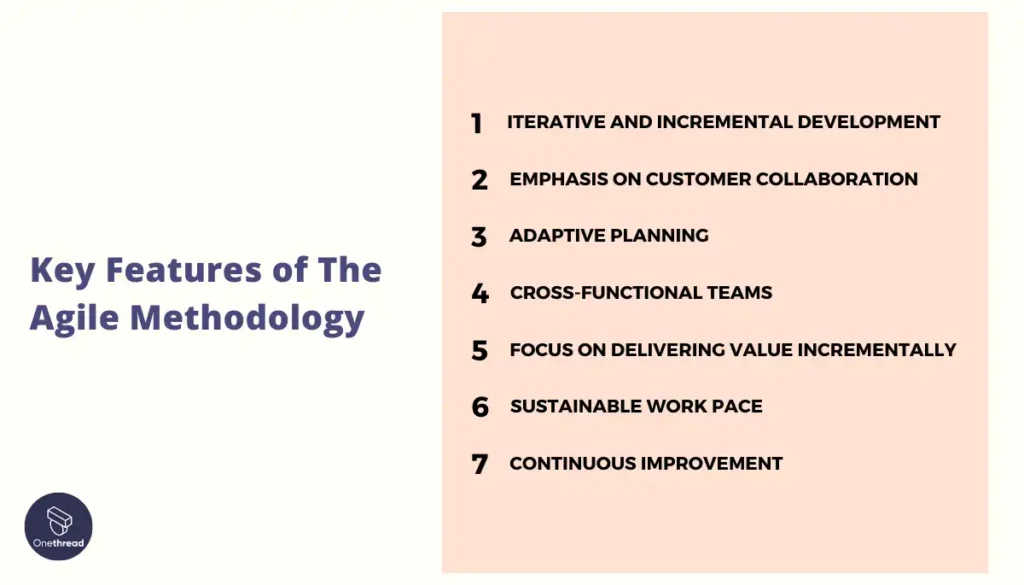
Agile is designed for environments that demand flexibility, rapid development, and direct stakeholder engagement, making it ideal for projects with uncertain or evolving requirements.
This approach not only facilitates efficient and effective project management but also enhances product quality and customer satisfaction.
Iterative and Incremental Development
Agile projects are characterized by their iterative and incremental nature, breaking down the project into manageable units called iterations or sprints. Each iteration involves a cycle of planning, executing, and evaluating, which allows for continuous improvement and adaptation.
This approach enables teams to quickly respond to changes and incorporate feedback, ensuring that the final product closely aligns with customer needs.
Emphasis on Customer Collaboration
Unlike traditional methodologies that set requirements at the beginning of a project, Agile methodology prioritizes ongoing customer collaboration. Regular feedback sessions with stakeholders are integral, ensuring that the development process remains aligned with customer expectations and business objectives.
This continuous engagement results in a more relevant and valuable product.
Adaptive Planning
Agile methodology supports adaptive planning, acknowledging that project scopes and requirements can change.
This flexibility allows teams to adjust their strategies and priorities based on the latest insights, market trends, or customer feedback, without being strictly bound by an initial plan.
Cross-functional Teams
Agile projects are often executed by cross-functional teams that possess all the skills necessary to deliver a product increment. This setup promotes a collaborative culture where team members share responsibilities and work closely together, breaking down silos and accelerating the development process.
It enhances the team’s ability to solve problems creatively and efficiently.
Focus on Delivering Value Incrementally
Rather than waiting until the end, Agile emphasizes delivering tangible value to customers or stakeholders in short cycles. Each iteration aims to produce a working increment that can be reviewed, tested, and deployed if desired. This approach ensures continuous progress and allows for early validation and feedback.
Sustainable Work Pace
Agile promotes maintaining a sustainable pace of work, recognizing that burnout is counterproductive. By promoting regular hours and avoiding overwork, Agile aims to keep teams productive and motivated over the long term.
This approach contributes to a healthier work environment and higher-quality outcomes.
Continuous Improvement
A fundamental aspect of Agile methodology is the commitment to continuous improvement. Through regular retrospectives, teams reflect on their processes, practices, and interactions to identify areas for enhancement.
This commitment to introspection and optimization drives efficiency and effectiveness, ensuring that the team evolves and improves throughout the project lifecycle.
While these methodologies offer distinct features, it’s important to also consider their potential advantages and limitations.
Advantages of Traditional Project Management
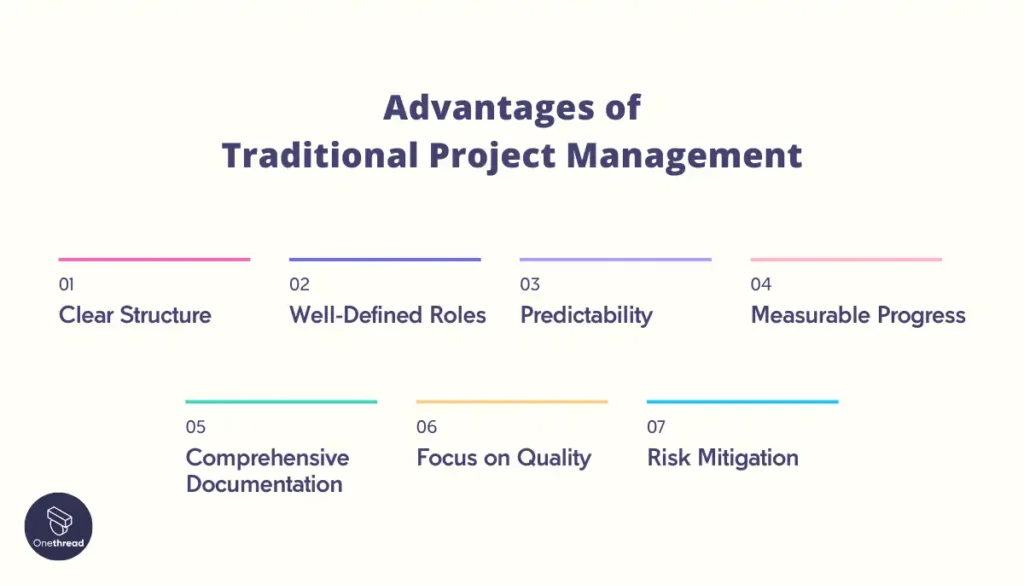
Traditional Project Management offers a structured approach, providing clear, predefined phases and milestones that ensure projects are completed systematically.
This method excels in predictability, allowing for detailed upfront planning and control over scope, cost, and time. Ideal for projects with fixed requirements, it ensures stability and thorough documentation throughout the project lifecycle.
Let’s explore its benefits:
Clear Structure
Traditional project management follows a well-defined structure throughout the project lifecycle. This clear roadmap outlines all phases, activities, and deliverables, allowing teams to maintain focus and avoid deviations.
Well-Defined Roles
Roles and responsibilities within the project team are clearly delineated from the start. This eliminates confusion over who is accountable for what, facilitating smooth collaboration.
Predictability
With extensive upfront planning, traditional approaches enable accurate forecasting of timelines, costs, and resource requirements. This predictability assists in setting realistic expectations.
Measurable Progress
By breaking down the project into distinct phases or milestones, teams can easily track progress against the established plan. This transparency provides clarity on project status.
Comprehensive Documentation
Detailed documentation of requirements, plans, designs, test cases, and more are maintained. This documentation serves as an audit trail and knowledge base for the project.
Focus on Quality
The emphasis on rigorous planning and adherence to processes instills a culture of quality. Proper review and testing mechanisms are built into each phase to identify and address issues early.
Risk Mitigation
Potential risks are identified and analyzed during the planning stages. This allows for the development of mitigation strategies to minimize the impact of risks should they occur.
Advantages of Agile Project Management
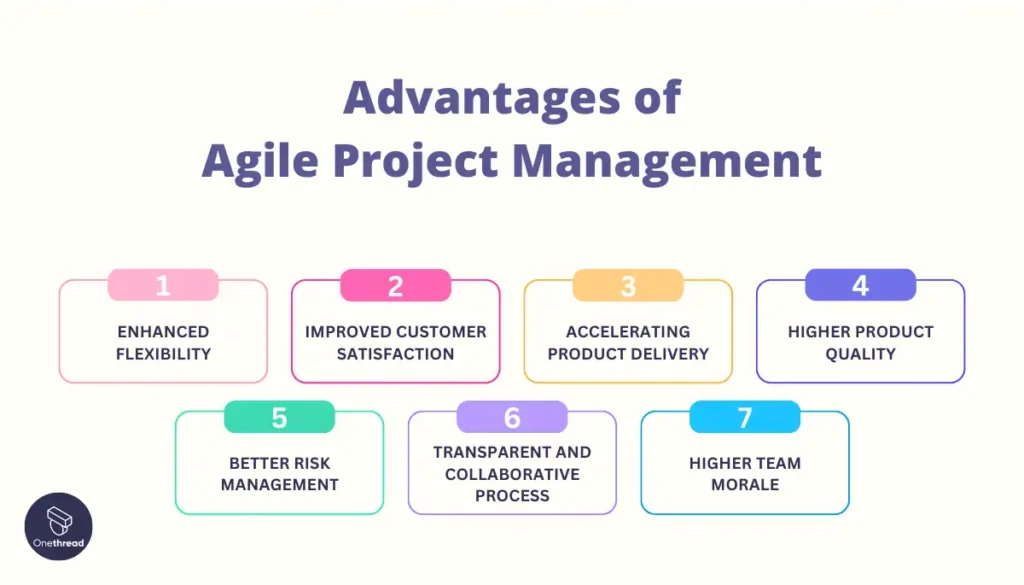
Agile Project Management offers a dynamic approach to handling projects, emphasizing flexibility, customer satisfaction, and continuous improvement.
This methodology adapts quickly to changes, ensuring that the end product not only meets but often exceeds customer expectations, all while maintaining high team morale and project efficiency.
Let’s explore its key advantages:
Enhanced Flexibility
Agile project management stands out for its remarkable flexibility. It allows teams to adjust their course based on evolving requirements or feedback without derailing the project. This adaptability ensures that the project remains aligned with client needs and market trends.
Improved Customer Satisfaction
By involving customers throughout the project and prioritizing their feedback, Agile ensures that the final product closely aligns with customer expectations. This continuous engagement leads to higher satisfaction levels, as customers see their input directly influencing the project outcome.
Accelerating Product Delivery
Agile’s iterative approach, with its emphasis on delivering working increments, allows for portions of the project to be released earlier. This not only provides immediate value to customers but also significantly reduces the time to market compared to traditional methods.
Higher Product Quality
Regular reviews and iterations within Agile project management enable continuous quality improvements. Each cycle offers the opportunity to refine and enhance the product, leading to a higher-quality output that is thoroughly tested and aligned with user needs.
Better Risk Management
The iterative nature of Agile allows for early detection of potential issues and risks, facilitating prompt mitigation. This proactive stance on risk management ensures that the project remains on track and within scope, minimizing surprises.
Transparent and Collaborative Process
Agile provides stakeholders with greater project visibility and control through regular updates and feedback sessions. This transparency ensures that all parties are well-informed about project progress, changes, and outcomes, fostering trust and collaboration.
Higher Team Morale
Agile’s collaborative environment and emphasis on empowerment boost team morale. Team members have a say in the project’s direction and are encouraged to take ownership of their work, leading to increased engagement, satisfaction, and productivity.
Agile Project Management not only streamlines project execution but also creates an environment where innovation thrives. Through its focus on customer collaboration, adaptability, and a commitment to quality, Agile delivers significant advantages over traditional project management methodologies.
Disadvantages of Traditional Project Management
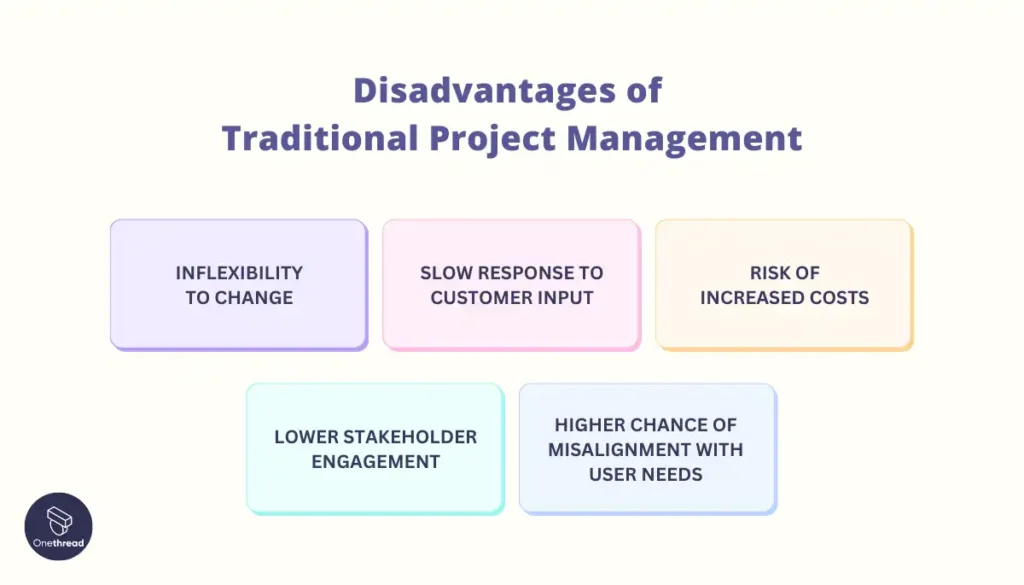
Traditional Project Management, with its structured and linear approach, often struggles in rapidly changing environments. This methodology’s reliance on detailed upfront planning and fixed project phases can lead to inefficiencies, making it challenging to adapt to new information or evolving customer needs.
Let’s look at why it might be tricky:
Inflexibility to Change
A significant drawback of traditional project management is its inflexibility. Once a plan is set, deviating from it due to changing requirements or unexpected challenges can be cumbersome and often requires extensive revisions and approvals, slowing down the project’s progress.
Slow Response to Customer Input
Traditional methods typically involve long phases before any working version is presented to the customer. This delay in integrating feedback can lead to a final product that may not fully meet the client’s current needs or expectations, as initial requirements may have evolved.
Risk of Increased Costs
The rigidity of traditional project management can lead to significant cost overruns if changes are necessary late in the project. Since the methodology does not easily accommodate adjustments, any alterations required can be costly and time-consuming to implement.
Lower Stakeholder Engagement
Stakeholder and customer engagement tend to be more limited and formal in traditional project management, often restricted to the beginning and end of the project. This limited involvement can reduce the opportunity for ongoing input and collaboration, potentially diminishing the project’s alignment with stakeholder objectives.
Higher Chance of Misalignment with User Needs
Due to the lengthy development cycles typical in traditional project management, there’s a risk that the project’s end product may no longer align with user needs or market conditions by the time it is delivered. This disconnect can result in solutions that are outdated or less effective than intended.
Traditional Project Management offers a high degree of predictability and control for projects with clear, unchanging requirements. However, its disadvantages become apparent in dynamic environments where flexibility, rapid feedback integration, and stakeholder collaboration are crucial for success.
Disadvantages of Agile Project Management
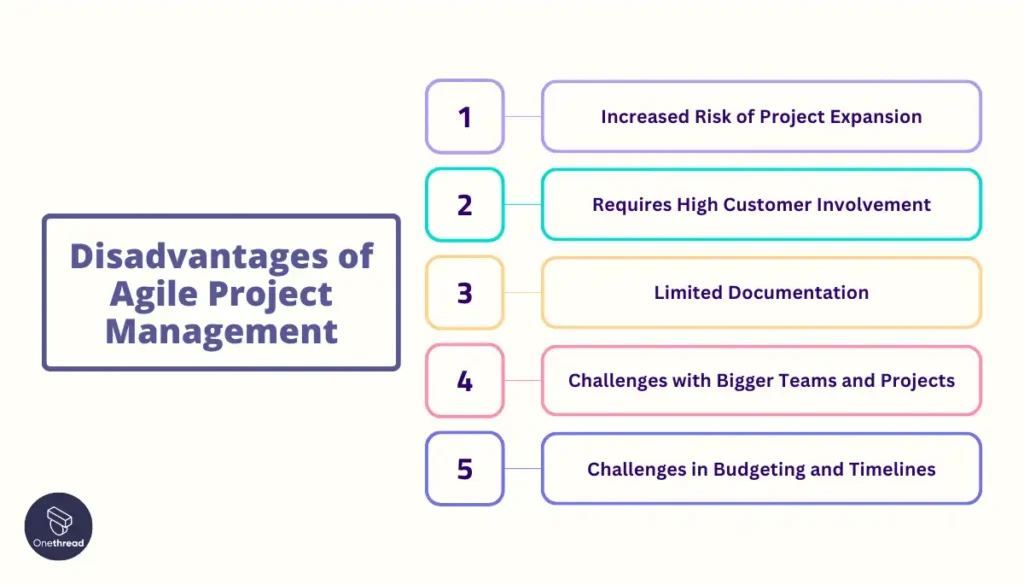
Agile Project Management offers flexibility but can also lead to some challenges, especially if not everyone agrees on the taste.
Let’s explore a few disadvantages:
Increased Risk of Project Expansion
Agile’s openness to change and continuous feedback can inadvertently lead to scope creep, where the project’s goals and features expand beyond the original plans without proper control, potentially impacting timelines and budgets.
Requires High Customer Involvement
Agile relies heavily on ongoing customer involvement and feedback, which can be a double-edged sword. Projects may suffer if stakeholders are unavailable for regular reviews or if there is a lack of clear, consistent communication from the client’s side.
Limited Documentation
The Agile focus on working software over comprehensive documentation can result in insufficient documentation, leading to challenges in knowledge transfer, onboarding new team members, or maintaining and scaling the product in the future.
Challenges with Bigger Teams and Projects
Implementing Agile methodologies in large, complex projects or organizations can be challenging. Coordination across multiple Agile teams, aligning with overarching business goals, and ensuring consistency becomes increasingly difficult as the project scale grows.
Challenges in Budgeting and Timelines
Agile’s iterative approach and flexibility make it difficult to predict the exact cost and delivery date at the project’s outset. This unpredictability can be a disadvantage in environments where fixed budgets and timelines are non-negotiable.
While Agile Project Management excels in adaptability and meeting customer needs, its disadvantages highlight the importance of carefully considering project scope, stakeholder involvement, and the project’s scale and documentation needs before choosing this methodology.
Similarity Between Traditional and Agile Project Management
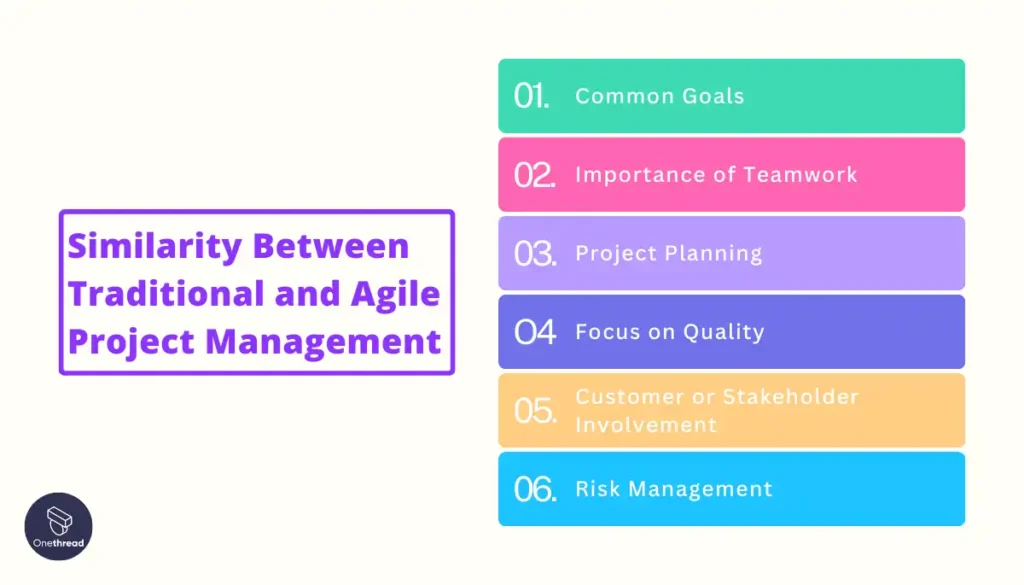
Traditional and Agile Project Management may seem like different worlds, but they share common ground. Both aim to complete projects successfully and satisfy stakeholders.
Let’s go into the similarities of Traditional and Agile Project Management.
Common Goals
At their core, both Traditional and Agile methodologies aim to deliver successful projects. They both focus on meeting project objectives and ensuring stakeholder satisfaction.
Importance of Teamwork
In Traditional Project Management, roles are clearly defined, and each team member contributes to the project based on their specific responsibilities.
Agile, on the other hand, promotes more collaborative teamwork, with members often wearing multiple hats.
Project Planning
Both methodologies involve planning, but the approach differs. Traditional Project Management emphasizes detailed upfront planning, while Agile focuses on flexible, iterative planning.
Focus on Quality
Quality is a non-negotiable aspect in both Traditional and Agile Project Management.
Each methodology has its way of ensuring quality, whether through rigorous testing phases in Traditional or continuous integration and testing in Agile.
Customer or Stakeholder Involvement
Both methodologies recognize the importance of customer or stakeholder involvement.
In Traditional Project Management, customer requirements are gathered upfront, and the project is executed accordingly.
Agile involves the customer as well but throughout the project, adapting to feedback along the way.
Risk Management
Managing risks is essential in both Traditional and Agile methodologies.
Traditional Project Management tends to identify and address risks during the planning stages, while Agile manages risks continuously through its iterative nature.
Despite their differences, Traditional and Agile Project Management share several similarities, including their ultimate goal of project success, the emphasis on teamwork, planning, quality, stakeholder involvement, and risk management.
How to Choose the Right Methodology for Your Project?
Choosing the right project management methodology is crucial for the success of your project. It involves aligning the project’s needs with the strengths of a methodology, whether that be the flexibility of Agile or the stability of Traditional methods. This decision can significantly impact your project’s efficiency, outcome, and team morale.
Let’s explore how to pick the best route for your project’s journey.
Step 1: Understand Your Project’s Needs
First, think about what you are trying to achieve from the project. Is everything clearly defined from the start, or do you expect things to change as you go?
If your project can be defined from start to finish before even initiating, you should choose traditional project management. However, if your project cannot be defined upfront and you expect changes or new requirements to emerge during the course of the project, you should choose agile project management.
Step 2: Consider Your Team’s Style
Look at your team. Do they like having a clear map to follow, or do they prefer making decisions on the fly? A team that enjoys structure might lean towards Traditional methods, while a team that thrives on flexibility might prefer Agile.
The functionality of your team plays a significant role in determining the right methodology. Agile thrives on collaboration, frequent communication, and adaptability. It suits teams comfortable with uncertainty, valuing flexibility and continuous improvement.
Specialized teams may prefer traditional methods with defined roles and structured workflows. Agile empowers teams to quickly adapt, solve problems collectively, and innovate, making it ideal for those embracing change and seeking constant development.
Step 3: Evaluate Stakeholder Involvement
Think about how much your stakeholders want to be involved. If they like to see progress and give feedback regularly, Agile’s open and collaborative approach might be best. If they prefer just seeing the final result, a traditional approach should work better.
Step 4: Assess Your Risk Tolerance
Consider how much uncertainty you can handle. Agile is good at dealing with changes and unknowns because it adapts as you go. Traditional is more about planning everything upfront to minimize surprises.
Step 5: Determine Your Project’s Complexity
Look at how complicated your project is. For complex projects where goals might change, agile allows you to adjust more easily. For simpler projects with well-defined steps, traditional might be the way to go.
Step 6: Choosing the Right Path
After considering these factors, you can better decide which methodology suits your project.
Remember, there’s no one-size-fits-all answer. The best approach might even be a blend of both methodologies, adapting to your project’s unique needs.
So, choosing the right project management methodology involves understanding your project, team, stakeholders, and the level of flexibility you need.
When is Agile Better Than Traditional?
Agile methodologies are often better than traditional approaches when requirements are dynamic, flexibility is valued, and continuous customer collaboration is essential.
Here are some situations where agile suits better than traditional-
- If the project has dynamic and evolving requirements that are likely to change frequently throughout its lifecycle:
Agile is well-suited for projects where requirements are likely to change frequently, as it accommodates continuous feedback, adaptation, and reprioritization throughout the project’s lifecycle.
- If rapid delivery and fast time-to-market are critical priorities for realizing value early:
By breaking work into smaller, iterative cycles, Agile allows for frequent delivery of working software, enabling faster time-to-market and early realization of value.
- If the project requires collaboration with customers/stakeholders and cross-functional teams:
Agile emphasizes close collaboration with customers, stakeholders, and cross-functional teams, ensuring that the product being developed aligns with evolving needs and expectations.
- If there is a high potential for change, uncertainty, or unpredictability:
Agile methodologies are designed to handle change and uncertainty effectively, making them advantageous in rapidly changing business environments, markets, or technologies.
- If enhancing quality and reducing risks through continuous testing, integration, and feedback loops is essential:
Through continuous integration, testing, and feedback loops, Agile helps identify and address issues early, improving overall quality and reducing the risk of costly rework or project failures.
- If promoting innovation, creativity, and continuous improvement is a key objective for the project:
The iterative and collaborative nature of Agile encourages experimentation, creativity, and continuous improvement, fostering an environment conducive to innovation.
- If increased transparency and visibility into progress, issues, and bottlenecks are needed for effective decision-making:
Agile practices, such as daily stand-ups, burndown charts, and retrospectives, provide greater visibility into project progress, issues, and bottlenecks, enabling proactive decision-making and course correction.
- If having motivated, self-organizing teams with shared ownership and continuous learning is desired:
Agile empowers and motivates teams by promoting self-organization, shared ownership, and continuous learning, leading to increased productivity and engagement.
- If the ability to quickly adapt to changing business priorities or market conditions is valued:
Agile’s flexibility allows teams to quickly adapt to changing business priorities, market conditions, or strategic shifts, minimizing waste and maximizing value delivery.
- If the project involves co-located, cross-functional teams that can collaborate closely and enable rapid decision-making:
Agile thrives in environments where cross-functional teams can collaborate closely, enabling effective communication, knowledge sharing, and rapid decision-making.
When is Traditional Better Than Agile?
Traditional project management approaches can be better than Agile in scenarios where requirements are well-defined, change is minimal, and a predictive approach is suitable.
Here are some situations where traditional suits better than agile-
- If the project has well-defined and stable requirements that are unlikely to change significantly during its lifecycle:
If the project requirements are clear, comprehensive, and unlikely to change significantly during the project’s lifecycle, a traditional approach with upfront planning and sequential execution can be more efficient.
- If the project has low complexity, minimal uncertainties, and low risk, requiring less frequent adaptation and course correction:
For projects with low complexity, minimal uncertainties, and low risk, traditional approaches with a predefined plan and schedule can work well, as there is less need for frequent adaptation and course correction.
- If the project operates in an industry that requires extensive documentation and rigorous processes:
In industries with stringent regulatory requirements or strict governance protocols, traditional approaches with comprehensive documentation and rigorous processes may be preferred to ensure compliance and minimize risks.
- If the project involves working with well-established technologies and proven methodologies:
When working with well-established technologies and methodologies, traditional approaches that leverage proven best practices and templates can be effective, as there is less need for experimentation and flexibility.
- If the project operates under a fixed-price contract with a predetermined scope, timeline, and budget:
In fixed-price contracts where the scope, timeline, and budget are predetermined, a traditional approach with detailed planning and defined deliverables can be advantageous for managing costs and meeting contractual obligations.
- If the project is large-scale and needs extensive upfront planning and hierarchical management structures:
For large-scale projects with numerous interdependencies and a high degree of complexity, traditional approaches with extensive upfront planning, detailed documentation, and hierarchical management structures may be more suitable for coordinating and controlling the project.
- If the organization has limited resources or expertise in Agile practices:
If an organization lacks experienced Agile practitioners or the necessary resources to support frequent iterations and continuous adaptation, a traditional approach with a more structured and linear execution may be more feasible.
- If project teams are geographically distributed or outsourced, requiring clear documentation, defined handoffs, and formal communication channels:
In cases where project teams are geographically distributed or outsourced, traditional approaches with clear documentation, defined handoffs, and formal communication channels can be beneficial for ensuring consistency and coordination.
However, the choice between traditional and Agile approaches should be based on a careful evaluation of the project’s specific characteristics, organizational culture, and team capabilities.
In many cases, a hybrid approach that combines elements of both traditional and Agile methodologies may be the most effective solution.
FAQs
What is the difference between the traditional and Agile lifecycle?
The traditional lifecycle is linear, with distinct phases completed one after another. Agile lifecycles are iterative, focusing on incremental progress through sprints and frequent reassessment.
What is the difference between traditional and Agile mindset?
A traditional mindset emphasizes planning, predictability, and control, aiming to minimize changes. An Agile mindset values adaptability, collaboration, and customer feedback, welcoming change as a path to improvement.
What is the difference between traditional and modern project management?
Traditional project management relies on a structured, sequential approach with fixed scopes and heavy documentation. Modern (Agile) project management emphasizes flexibility, stakeholder involvement, and adapting to change rapidly.
Wrap-Up
So, choosing between Traditional and Agile project management methods is akin to selecting the right tool for the job. Traditional methods shine in scenarios where clarity and predictability reign supreme, offering a structured roadmap to follow.
Agile, however, thrives in fluid environments where flexibility and rapid adaptation are key, making it ideal for projects in ever-changing landscapes. Your decision should hinge on the specific demands of your project, the composition of your team, and the expectations of your stakeholders, ensuring you navigate toward success in today’s dynamic project terrain.
